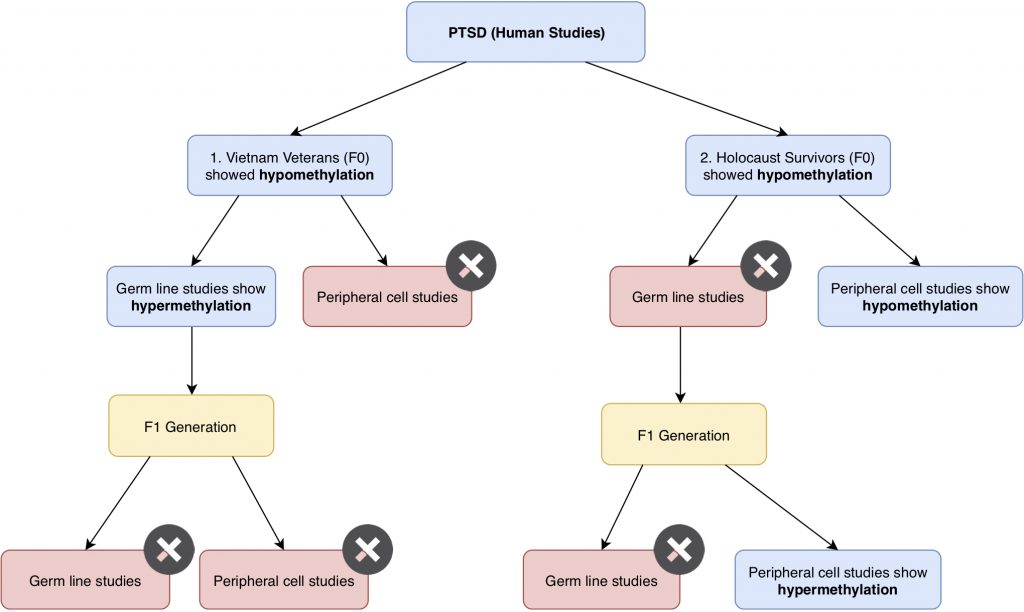
As previously mentioned, the field of epigenetics has only fairly recently been delved into. Because of this, there are a still studies that need to be done to investigate the epigenetics of PTSD, leaving some gaps in the published research. There are many challenges to completing these studies, primarily due to ethical and longitudinal issues. For this reason, we used a combination of multiple studies to form our hypothesis, each focusing on one aspect of epigenetic inheritance. Figure 4 shows a visual map of how the information from studies that we used fits together as well as the gaps in the current research.
One paper we looked at studied the germline cells (sperm cells) of Vietnam war veterans. Mehta et. al found that the sperm cells of the F0 generation were hypermethylated at the loci of interest. No studies of the peripheral cells in the F0 were done, and no studies of DNA in the F1 generation were done. We supplemented the data from this paper with a paper on the offspring of Holocaust survivors. This study reported hypomethylation in peripheral (not germline) blood cells of the F0 generation. They also completed studies of the peripheral cells of F1 generation and found hypermethylation at the loci of interest. These researchers did not complete any germline studies of the F0 or F1 generations. We use these studies to complement each other in our explanation of the epigenetic inheritance of PTSD.
Our project looks at the inheritance of mental illness, and to further research in mental illness in general, brain samples could be valuable. From an ethical standpoint, there are limitations on using human brain samples; not only is consent required from the patient or family members, but brain samples themselves are exceedingly difficult to obtain. From a longitudinal standpoint, the major issue stems from the fact that human studies take much longer than animal studies; not only must researchers wait for veterans to consent to/give a brain sample, but they also must wait for children to mature in order to test their germline cells.
It should also be noted that PTSD methylation patterns have been shown to be sex-specific (3); thus, we chose to focus our review the epigenetic inheritance of paternal human PTSD. Ideally, we would have used mice studies to supplement our research; however, the majority of mice studies focus on the inheritance of maternal PTSD.
It is not completely clear why the F0 generation has hypomethylation in peripheral cells while the F1 generation has hypermethylation in peripheral cells at the same loci. However, a study of cancer and tumorigenesis proposed that DNA methylation and demethylation might be used as a epigenetic repair mechanism to try to correct for altered methylation patterns (8).While this hypothesis has not been proven to apply directly to our research of PTSD, we hypothesize that this compensation mechanism might act in other cases of epigenetic inheritance as well.

I think this page is really helpful after the general epigenetics page which gives a lot of info. This page grounds the reader and applies what was just said on the last page to your project. It is clear that there are some complexities you had to deal with when looking into this topic, but i think you do a really good job digesting the complexities and showing the overall picture.
A question I had that you might be able to elaborate on in a few words when introducing brain sampling in paragraph 2: Why are brain samples the samples that are needed for these studies, if the methylation occurs in peripheral cells, would other cells that aren’t germline show the same patterns? You jumped to the ethical problem of brain sampling before explaining why brain sampling needs to be done.
small grammar note:
Paragraph 3: need the word “on” in “thus, we chose to focus our review ON the epigenetic inheritance of paternal human PTSD:
Thanks for pointing out the gap in the brain sampling section. We added a sentence to put it in the context of our project. In terms of the research currently being done, most people are just testing peripheral blood and germ line cells, but brain samples could be useful as well to see the methylation patterns in the brain tissue. And we’ll fix the grammatical issues!
I really appreciate the figure, since it more or less summarizes what you guys are focusing on and what’s still missing. What I don’t really understand about the figure is how the Germ Line studies for the Holocaust studies is marked as missing, yet the peripheral cell studies for the F1 generation demonstrate hypermethylation? Or does the figure instead suggest that a possible hypothesis is that peripheral cells of the F1 will show hypermethylation if the parents had hypomethylation?
Also, to add onto Claire’s point, it would be nice to understand they test for methylation and what tissue samples are actually necessary for testing methylation.
Yes, the figure is meant to show exactly that. When parents have hypomethylated DNA, the children will have hypermethylated DNA. We are also adding a written summary to clarify any confusions about the chart. Thanks for your comment!
Your hypothesis is extremely interesting–it would be helpful to the reader for you to clarify what is meant by “compensation” when you say that “[maternal] germ cells compensated for the hypermethylation…” on a biochemical level so that the reader has a better understanding of how such a feat is accomplished.
We have edited that portion of text. The mechanism of compensation is still being researched and currently unclear. It is a still a preliminary research!
As someone who is not that educated on this subject, I am a bit confused by some of the terminology that is used on this page and think that further clarification could be helpful. Mainly i mean references to germline (also make sure that it is consistently written with or without a space) and peripheral cells. How do the different results from these studies indicate different states of the DNA?
I think the figure is definitely useful, but with even more explanation on terminology would help with understanding of the rest of the site even more.
We have added a brief definition of peripheral and germ line cells. Hopefully this will help!